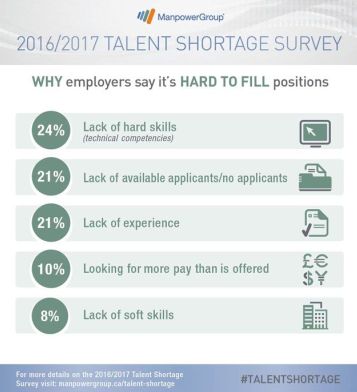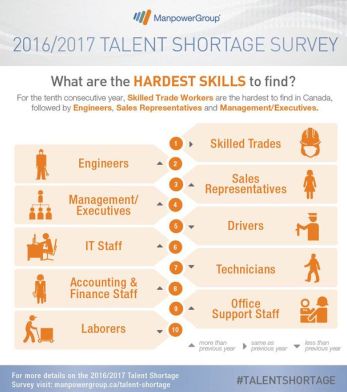Canadian employers say that they are struggling to hire the employees they need. More than half of the organizations surveyed (56 per cent) by Manpower for their 2016/2017 Talent Shortage Report say that a lack of skilled workers available is having a medium to high impact on their abilities to meet business needs.
This most recent data from Manpower indicate that the demand for skilled workers is at its highest level in a decade, since before the 2008 recession. At last check, Canada still had a roughly 7 per cent unemployment rate – there are lots of people looking for work right now.
Why are businesses having trouble hiring?
 Here’s what the employers surveyed had to say:
Here’s what the employers surveyed had to say:
- Candidates lacked the necessary skills to do the job
- No (or not enough) people applying for the jobs
- Applicants lacked experience
- Potential employees wanted more money than the employers were willing to pay
- Candidates were lacking in soft skills
Let’s talk about answer number four for a second. There is no shortage of skilled workers if people with the requisite skills apply but employers are unwilling to pay them enough money to bring them onboard. That’s a labour market supply and demand issue. If companies want to hire in a shrinking pool of candidates, they’ll have to increase their pay to meet market demands.
Case in point. I was once consulting with a client company for a job board I worked for. They could not hire enough candidates to keep the nightshift running in their warehouse. The jobs weren’t terribly technical, so no unique skillset was required, just the ability to show up on time and have a decent work ethic through the shift.
So, what was the problem? The warehouse was located north of the 401 highway in Toronto and difficult to get to by public transit during the day. Impossible to get to without a car for the night shift. However, the jobs paid only slightly better than minimum wage – not enough to own and maintain a car in one of the country’s most expensive cities.
I was supposed to coach the client on employer branding – how to market themselves better in job ads to attract people to the night shift. They asked me if I thought mentioning that they had a ping pong table would help. I said that I didn’t think that was the issue.
Here’s what the average Canadian jobs pay by region and industry.
Anyway. According to Manpower, for the tenth year in a row, the lack of qualified workers is most acute in the skilled trades. Engineers, sales reps, management, drivers and techies are also in high demand.
 The hardest to fill jobs?
The hardest to fill jobs?
- Skilled Trade Workers
- Engineers
- Sales Representatives
- Management/Executives
- Drivers
- IT Staff
- Technician
- Accounting & Finance Staff
- Office Support Staff
- Labourers
Recent data released by Indeed.com, perhaps the world’s biggest job board, found that online job ads remained posted for longer in 2016 than 2015. Nearly a quarter of jobs posted online (22 per cent) stayed up for over 60 days last year.
According to their numbers, Canada ranked second in the world (after only the US) for jobs going unfilled.
“Job postings that stay open over 60 days are an indicator that employers are leaving roles open for an extended period,” said Jodi Kasten, MD at Indeed Canada. “This may be for a variety of reasons, including that employers aren’t finding the talent they need, that they’re hiring multiple people into the roles, or that they don’t have a lot of pressure to fill the roles.”
It’s been a decade of slow growth and limited job creation since the great recession. These numbers indicate that the pendulum is gradually swinging back towards increased hiring and the return of a candidate job market.
(Which is good news since last summer’s Employment Outlook Survey revealed one of the weakest job markets in years. Yes, I read them all. The latest employment numbers from Stats Can will come out on Friday morning. Stay tuned.)